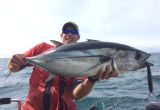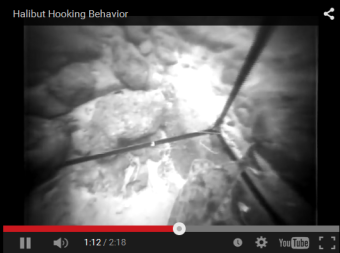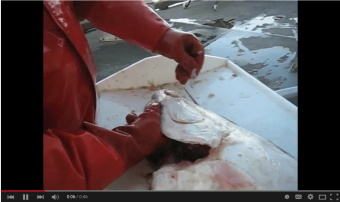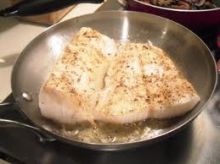Halibut Hooking Behaviour
How to catch halibut can become easy by utilizing some important principles that happen in nature while halibut are on the hunt and feeding on their prey. We hope these tips help you catch more Halibut.
Halibut Hooking Research
|
Ongoing amazing Halibut research is being done by the International Pacific Halibut Commission. They have been running tests for over 20 years utilizing 100’s of thousands of pounds of chum salmon as bait annually on miles of set lines with over 500 hooks on each. They have tested hook size, knots, bait, current, etc. Thousands of gear sets one way were compared to thousands set another way. image and video source: IPHC |
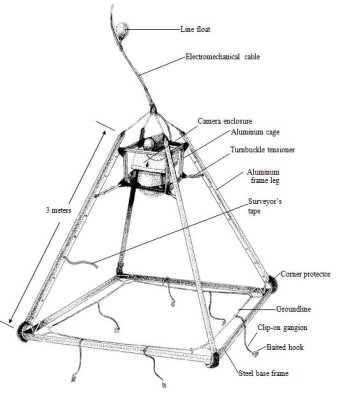 |
Direction of the current is the essential element
There are also some that approach from other directions as well, but the interesting factor is that of all those that approached from all directions, those that approached from down stream had a higher proportion of “attack” rate than those from other approaches.
Halibut are Suction Feeders
Halibut are suction feeders, meaning that they use their giant gill plates to create a seal and then open quickly with a giant suction effect, creating a fast flow of water inwards through their mouth, that sucks in prey (and bait).
Their research has also shown that fish that are hooked directly on the bottom are hooked on the white side corner of the mouth. This is because Halibut, when on the bottom, are dark-side up and white side down. When they take the bait on the bottom, they swim upward and turn, thus the hook engaging on the white side. But the opposite occurs when they take a bait mid water, they take the bait and then swim downward so the hook engages in the dark side of the halibuts mouth.
| A surprising result of the study was in the case of using circle hooks in a commercial environment. How the hook was tied on could change hooking success by up to 50%. Tying the loop through the front of the eye doubled the hook up rate compared to those tied through the back of the eye. Another take away was the larger the fish, the higher the hook up rate. A 20 pound fish had twice the hook up rate than a 10 pound fish. Keep in mind however this is while on the bottom using bait. This result is likely related to hook size and that the small fish did not have a large enough mouth for the hook to engage. |
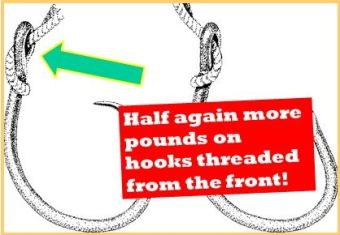 |
Key Tips for Successful Halibut hook ups
- Be aware of direction of current - if anchoring, use a piece of surveyors tape off the back of your stern somewhere so you can see the current. This can be tough to achieve if in a wind chop.
- Be strategic and Patient - When you set up and bait fishing for Halibut don’t always expect the fish to be right on top of the gear, be prepared to wait an hour and sometimes two for the fish to show up. Hopping from place to place while bait fishing is a poor strategy. Also thumping your weight on bottom also acts as an attractant as well, the fish can feel it.
- Fishing in groups - If a buddy calls you in because the Halibut bite is on, its not as simple as pulling up beside him. We have experienced this countless times, one boat catching one after another, while a boat nearly 50 feet away is catching none! This is because the fish are stacked up downstream of the other boats bait. If he is willing to share, get into his bait stream or above his bait stream. This way your bait stream is in the same line.
- If you are going to do a targeted trip using bait, be sure to set up before the slack tide so your bait scent has some time to travel. Keep in mind that even during the tide change there is still current.
- If baiting a jig with a triple hook, place the bait dangling from ONLY one of the prongs, do not jamb it onto all three, the bare prongs are what are going to hook the fish.
- Use additional scents if not using bait. Some very effective lures come scent injected.
| Halibut Lure/Rig | Why we like it | |
 |
Circle Hook set up with bait hook by Gibbs Delta | The circle hook is a proven winner for fishing bait, the circle digs deeper as the fish pulls. We like this rig because it has an additional hook on the rig for holding the bait. |
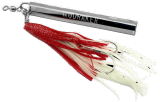 |
Gibbs Delta Mud Raker Red or Orange with Glow or white inner |
A main stay in the halibut or bottom fishery. The big lead thumps the bottom while the lure is adjacent to it. Sound attracts the fish. Also the hook is shorter than the weight so less snag ups on bottom. (great for novice). It also has a scent chamber. |
 |
Gibbs Delta Jigalu with white or glow or white body. |
Have caught some huge halibut on this rig. Like the extra hook for bait placement. The head rides low bouncing while the hook points up. |
 |
Gibbs Delta Big Eye Jig with glow body or white body |
Similar to the Jigalu. but only one big single hook. The skirt around the neck brings lots of life to this lure |
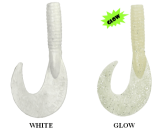 |
Gibbs Delta Bio X Scent injected jig bodies. Hali Hawg |
Scent is essential and these jig bodies have demonstrated they work great when bait isnt always an option. Some guides prefer these over bait. Whatever those guys over at Gibbs Delta are putting in these jig bodies is amazing stuff. Its a trade secret I am told. |
Kyuquot Halibut Fishing
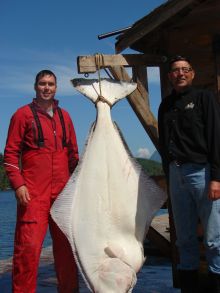 |
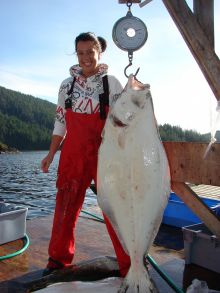 |
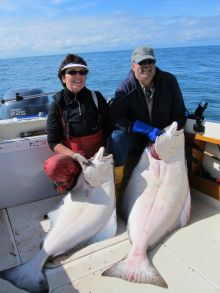 |
The Halibut fishing outside of Kyuquot Sound is excellent. There are good numbers of Chicken Halibut which are 12 to 25 pounds and a fair number of larger fish which range in the 60 to 120 pounds. We have encountered fish in excess of 250lbs. The new regulations require that we now release the really big ones such as the one shown in the photo on the left.
You are able to retain two halibut total on a fishing trip, with a maximum of one per day. Only one of these fish can but up to approximately 70 pounds (133cm) and the other must be under aproximately 23 pounds (90 cm). Here is the regulations on the species
All of the Halibut fishing is in a radius of 15 miles from our camps. The water is 150 to 300 feet deep and we use 16 to 20 ounces of lead to stay on bottom. We pick our weather to go Halibut fishing and generally try to go first thing in the morning to take advantage of the morning calm.
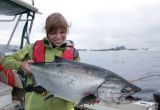
Kyuquot Sound Lodge
Nestled in the tiny village of Kyuquot, our land based lodge is just minutes to the fishing grounds. This location has 800 feet of water front, with plenty of room to stretch your legs. Your equipment and guides are top notch and the lodge accommodates up to 35 guests Trip Details »